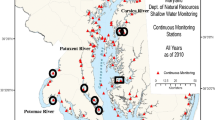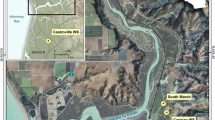Abstract
Dissolved oxygen concentration, which is often measured inestuaries to quantify the results of and stresses associatedwith eutrophication, can be highly variable with time of dayand tidal stage. To assess how well dissolved oxygenconditions are characterized by typical monitoring programs,we conducted Monte Carlo sampling from 16 semi-continuous,31-day dissolved oxygen records collected from estuaries alongthe Atlantic and Gulf coasts to mimic three samplingstrategies: (1) systematic point-in-time sampling, (2) randompoint-in-time sampling, and (3) short-term continuous records.These strategies were evaluated for their accuracy inestimating mean oxygen concentration, minimum oxygenconcentration, and percent of time below a threshold value of2 ppm. Mean dissolved oxygen concentration was most accuratelyestimated in both estuarine regions by random point-in-timesampling, but this strategy required more than ten samplingsper month for the estimate to be within 0.5 ppm on 50% of thesimulations. Short-term continuous sampling (24–48 h)correctly identified estuaries in the Gulf of Mexico regionwhere dissolved oxygen concentrations of less than 2 ppm wereexperienced greater than 20% of the time. However, largetidal variations in Atlantic coast estuaries showed thismeasure to be inaccurate in these estuarine environments. Noneof the sampling strategies correctly identified month-longoxygen minima within 0.5 ppm for more than 50% of thesimulations. This inability to characterize correctlydissolved oxygen conditions could add significant uncertaintyto risk assessments, waste load allocation models, and otherwater quality evaluations that are the basis for developingwastewater treatment strategies and requirements. Perhaps moreimportantly, the inaccuracy with which conventional samplingprocedures characterize minimum dissolved oxygen valuessuggests that the extent of hypoxia in estuarine waters inbeing substantially underestimated.
Similar content being viewed by others
References
Breitberg, D. L.: 1990, ‘Nearshore Hypoxia in the Chesapeake Bay: Patterns and Relationships Among Physical Factors’, Est. Coast. Shelf Sci. 30, 593–609.
Brungs, W. A.: 1971, ‘Chronic Effects of Low Dissolved Oxygen Concentrations on the Fathead Minnow (Pimephales promelas), J. Fish. Res. Bd., Canada 28, 1119–1123.
Burd, B. J. and Brinkhurst, R. O.: 1984, ‘The Distribution of the Galatheid Crab Munida quadrispina (Benedict 19202) in Relation to Oxygen Concentrations in British Columbia Fjords’, J. Exp. Mar. Biol. Ecol. 81, 1–20.
Burton, D. T., Richardson, L. B. and Moore, C. J.: 1980, ‘Effect of Oxygen Reduction Rate and Constant Low Dissolved Oxygen Concentrations on Two Estuarine Fish’, Trans. Amer. Fish. Soc. 109, 552–557.
Butler, P. J., Taylor, E. W. and McMahon, B. R.: 1978, ‘Respiratory and Circulatory Changes in the Lobster (Homarus vulgaris) during Long Term Exposure to Moderate Hypoxia’, J. Exp. Biol. 73, 131–146.
Carpenter, J. H.: 1965, ‘The Accuracy of the Winkler Method for Dissolved Oxygen Analysis’, Limnol. Oceanogr. 10, 135–140.
Coutant, C. C.: 1985, ‘Striped Bass, Temperature, and Dissolved Oxygen: A Speculative Hypothesis for Environmental Risk’, Trans. Amer. Fish. Soc. 114, 31–61.
DeFur, P. L., Magnum, C. P. and Reese, J. E.: 1990, ‘Respiratory Responses of the Blue Crab Callinectes sapidus to Long-term Hypoxia’, Biol. Bull. 178, 46–54.
Gaston, G. R.: 1985, ‘Effects of Hypoxia on Macrobenthos of the Inner Shelf off Cameron, Louisiana’, Est. Coast. Shelf Sci. 20, 603–613.
Hagerman, L. and Szaniawska, A.: 1986, ‘Behaviour, Tolerance, and Anaerobic Metabolism under Hypoxia in the Brackish-water Shrimp Crangon crangon’, Mar. Ecol. Prog. Ser. 34, 125–132.
Harper, D. E., McKinney, D. L., Salzter, R. R. and Case, R. J.: 1981, ‘The Occurrence of Hypoxic Bottom Water off the Upper Texas Coast and its Effect on Benthic Biota’, Contrib. Mar. Sci. 24, 53–79.
Holland, A. F., Shaunghessy, A. T. and Heigel, M. H.: 1987, ‘Long-term Variation in Mesohaline Chesapeake Bay Benthos: Spatial and Temporal Patterns’, Estuaries 10, 227–245.
Jorgensen, B. B.: 1980, ‘Seasonal Oxygen Depletion in the Bottom Waters of a Danish Fjord and its Effect on the Benthic Community’, Oikos 34, 68–76.
Justic, D., Legovic, T. and Rottini-Sanori, L.: 1987, ‘Trends in Oxygen Content 1911–1984 and Occurrence of Benthic Mortality in the Northern Adriatic Sea’, Est. Coast. Shelf Sci. 25, 435–445.
Kanwisher, J. W.: 1959, ‘Polarographic Oxygen Electrode’, Limnol. Oceanogr. 4, 210–217.
Kapper, M. A. and Stickle, W. B.: 1987, ‘Metabolic Responses of the Estuarine Gastropod Thais haemastoma to Hypoxia’, Physiol. Zool. 60, 159–173.
Kramer, D. L.: 1987, ‘Dissolved Oxygen and Fish Behavior’, Environ. Biol. Fish. 18, 81–92.
Kuo, A. Y. and Neilson, B. J.: 1987, ‘Hypoxia and Salinity in Virginia Estuaries’, Estuaries 10, 277–283.
May, E. B.: 1973, ‘Extensive Oxygen Depletion in Mobile Bay, Alabama’, Limnol. Oceanogr. 18, 353–366.
Officer, C. B., Biggs, R. B., Taft, J. L., Cronin, L. E., Tyler, M. A. and Boynton, W. R.: 1984, ‘Chesapeake Bay Anoxia: Origin, Development, and Significance’, Science 223, 22–27.
Pihl, L., Baden, S. P., Diaz, R. J. and Schaffner, L. C.: 1992, ‘Hypoxia-induced Structural Changes in the Diet of Bottom-feeding Fish and Crustacca’, Mar. Biol. 112, 349–361.
Renauld, M. C.: 1986, ‘Hypoxia in Louisiana Coastal Waters During 1983: Implications for Fisheries’, Fish. Bull. 84, 19–26.
Rombough, P. J.: 1988, ‘Respiratory Gas Exchange, Aerobic Metabolism, and Effects of Hypoxia during Early Life, in: Hoar, W. S. and Randall, D. J. (eds.) Fish Physiology, Volume XI, The Physiology of Developing Fish. San Diego: Academic Press, pp. 59–161.
Rosenberg, R.: 1985, ‘Eutrophication—The Future Marine Coastal Nuisance?’, Mar. Poll. Bull. 6, 227–231.
Rosenberg, R.: 1990, ‘Negative Oxygen Trends in Swedish Coastal Bottom Waters’, Mar. Poll. Bull. 21, 335–339.
Rosenberg, R. and Loo, L.: 1986, ‘Marine Eutrophication Induced Oxygen Deficiency: Effects on Soft Bottom Fauna, Western Sweden’, Ophelia 29, 213–225.
Rossignol-Strick, M. A.: 1985, ‘A Marine Anoxic Event on the Brittany Coast, July 1982’, J. Coast. Res. 1, 11–20.
Ryther, J. H. and Dunstan, W. M.: 1971, ‘Nitrogen, Phosphorus, and Eutrophication in the Coastal Marine Environment’, Science 171, 375–380.
Sanford, L. P., Sellner, K. G. and Breitberg, D. L.: 1990, ‘Covariability of Dissolved Oxygen with Physical Processes in the Summertime Chesapeake Bay’, J. Mar. Res. 48, 567–590.
Stachowitsch, M.: 1984, ‘Mass Mortality in the Gulf of Trieste: The Course of Community Destruction’, Mar. Ecol. 5, 243–264.
Swanson, R. L. and Parker, C. A.: 1988, ‘Physical Environmental Factors Contributing to Recurring Hypoxia in the New York Bight’, Trans. Amer. Fish. Soc. 117, 37–47.
Turner, R. E. and Allen, R. L.: 1972, ‘Bottom Water Oxygen Concentration in the Mississippi River Delta Bight’, Contr. Mar. Sci. 25, 161–172.
Author information
Authors and Affiliations
Rights and permissions
About this article
Cite this article
SUMMERS, J.K., WEISBERG, S.B., HOLLAND, A.F. et al. CHARACTERIZING DISSOLVED OXYGEN CONDITIONS IN ESTUARINE ENVIRONMENTS. Environ Monit Assess 45, 321–330 (1997). https://doi.org/10.1023/A:1005726718951
Issue Date:
DOI: https://doi.org/10.1023/A:1005726718951




